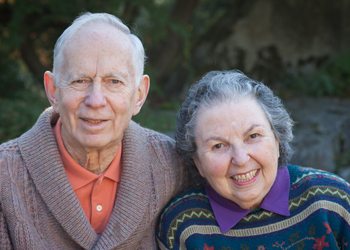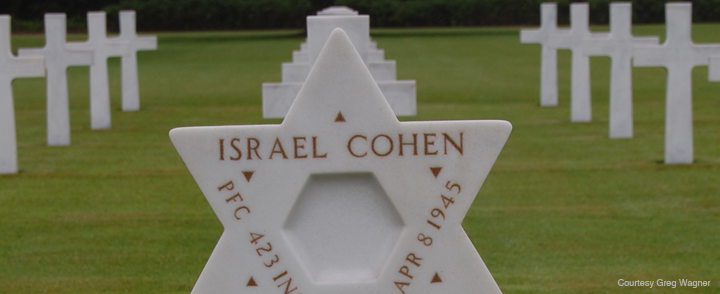By Marilyn Corets, Special to the Jewish Sound
Following the death of my mother, Roberta, on May 9, 2011, my father, Ellis Corets, started to dedicate his time to remembering American Jewish military members who never returned home from overseas combat. A Korean War veteran, now 82 years old, Dad conceived of, researched and compiled a database of nearly 3,000 military members who died serving our country.

Now, a year after Rabbi Jay Rosenbaum of Herzl-Ner Tamid Conservative Congregation on Mercer Island instituted the weekly practice of including a war hero’s yahrzeit — an annual remembrance of a person’s death — in the synagogue’s recitation of the Mourner’s Kaddish, Dad is sharing his database nationally with the hope that other Jewish communities will embrace the respect and honor with which it was created.
“The American Jewish War Heroes Yahrzeit Program is a weekly reminder that the freedoms we enjoy in our country rest on a foundation of bravery and sacrifice by previous generations of our people,” Rabbi Rosenbaum told me. “It’s so easy to get caught up in the news and problems of today. Every week, for a brief moment, remembering the yahrzeits of Jewish service personnel offers a deeper context to the blessings we so often take for granted.”
My mother, Roberta, of blessed memory, figures prominently in the development of the program, though she never served in the military. She serves as an inspirational silent partner. As Dad attended weekly Shabbat services with my family, he had a realization.
“It occurred to me as we stood for the Mourner’s Kaddish that a synagogue is much more than a place of learning, worship and gathering. Every sanctuary is also a place of remembrance,” he said. “And then on the Shabbat prior to Veterans Day, Rabbi Rosenbaum invited the veterans to stand and be recognized. As I stood there, my thoughts were with all the military members who did not return from war and are buried overseas.”
The more Dad thought about the synagogue as a place of remembrance and the perpetual nature of yahrzeits, the more he labored over how to honor the memory of service personnel killed in the line of duty. He decided to research and catalogue these service members so a name could be added to the synagogue’s yahrzeit list every week of the year.
In the spring of 2012, following the unveiling of Mom’s headstone, Dad happened to meet Robert Shay of Jewish War Veterans of the United States of America, Northwest Post 686, who was preparing the Herzl Memorial Park for Memorial Day. The chance meeting was a turning point. Shay introduced Dad to the American Battle Monument Commission (ABMC) website and a book published by the National Jewish Welfare Board. Both resources proved instrumental in Dad’s vision becoming reality.
After months of research and data entry, Dad’s simple spreadsheet required more horsepower. He enlisted my sister, Eva, to create an online database, and asked Rabbi Rosenbaum to implement the program on the Shabbat preceding Memorial Day 2013. The impact was immediate. In attendance at the Bat Mitzvah of Talia Chivo were her grandparents, Jack & Marion Chivo of West Vancouver, B.C. As Holocaust survivors liberated by American and Canadian troops, the Chivo Family (pronounced Kee-voe) was grateful to hear a Jewish American war hero included in the yahrzeit list. They viewed Ellis Corets as a hero himself, calling Dad a “Mitzvah hero” for taking on such an honorable and emotional initiative. Added David Chivo, father of Talia and son of Jack & Marion, “Our tradition teaches us that Zichronot – the encounter of our memories – underscore that the past is not only significant, but that we must learn from it to help create a better future. The work of the Corets Family lives this teaching and it was truly meaningful that our daughter’s Bat Mitzvah was the occasion when their project was inaugurated.”
To date, the yahrzeit program honors 2,750 American Jewish military personnel Killed in Action (K.I.A.) and Missing in Action (M.I.A.) in World War II and a small number Dad has been able to identify from World War I. These service members share the distinction that they didn’t return home — they are buried or memorialized in ABMC cemeteries and monuments overseas. (All recoverable remains from the Korean and Vietnam Conflicts were returned to the United States for interment at national or private cemeteries and thus are not part of this program.)
Using the Hebrew or secular calendar, a congregation prepares its weekly yahrzeit list and includes a service member whose yahrzeit occurs the following week. A short bio — name, rank, branch of service, hometown, honors, cemetery — is taken from the database and read with a brief statement of purpose, such as, “When we say Kaddish for (service member’s name), we say Kaddish for all service personnel killed in action or missing in action with yahrzeits this week.”
“The lovely thing about the dedication with which Ellis has pursued this is that we often learn something personal about the yahrzeit we’re observing,” Rabbi Rosenbaum said. “Whenever possible, Ellis provides a story to go with the name. That makes the observance more real and more inspiring.”
Of the countless hours Dad spent contemplating remembrance, conceptualizing the project, and developing the database, he says it’s all worth it when he hears the reactions of folks like Herzl-Ner Tamid member Greg Wagner, the grandson of a soldier killed in action during World War II.
“I am continually making sure that my children and I remember Israel Cohen, not just as a grandparent/great-grandparent, but also as a soldier and POW who sacrificed everything for our country and our allies,” Wagner said. ”Given that his name was Israel Cohen, the Germans didn’t just kill him because he was an American soldier, but rather they killed him specifically because he was a Jewish American soldier. Having him included in the American Jewish War Heroes Yahrzeit Project adds a special significance, because it combines the honor of his military service along with his Jewish heritage.”
The names of the service members killed and missing in action are sorted by the Hebrew and secular calendars, name, cemetery, and state. The program is available to all synagogues, Jewish museums, historical societies, archives, community centers, at no cost. The data, program guide, photos and supporting documentation can be downloaded at Jewish War Heroes Documents.
Marilyn Corets is a freelance writer and member of the board of directors of Herzl-Ner Tamid.
